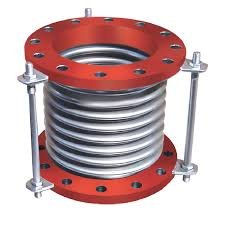Metal Expansion Joints: A Comprehensive Guide
Metal expansion joints play a crucial role in various industrial applications by accommodating thermal expansion, vibration, and movement in piping systems.

Metal expansion joints play a crucial role in various industrial applications by accommodating thermal expansion, vibration, and movement in piping systems. These components help to prevent damage and maintain system integrity in industries such as power generation, chemical processing, and HVAC systems. This article explores metal expansion joints, their types, applications, benefits, and factors to consider when selecting them.
What Are Metal Expansion Joints?
Metal expansion joints are flexible connectors installed in piping and duct systems to absorb thermal movements, mechanical vibrations, and other external forces. They are typically made from stainless steel or other high-performance alloys, which provide durability, strength, and resistance to extreme conditions.
These joints are designed to handle various types of movement, including axial, lateral, and angular displacements. By absorbing these movements, metal expansion joints reduce stress on pipes and other system components, prolonging their lifespan and preventing costly repairs.
Types of Metal Expansion Joints
1. Axial Expansion Joints
Axial expansion joints are designed to absorb linear movements along the axis of the piping system. They are commonly used in industries where thermal expansion is a primary concern.
2. Lateral Expansion Joints
Lateral expansion joints accommodate side-to-side movements. They are ideal for systems that require flexibility due to complex piping layouts.
3. Angular Expansion Joints
Angular expansion joints allow rotational movement and are typically used in piping systems with bends or curves.
4. Universal Expansion Joints
Universal expansion joints combine axial, lateral, and angular movement capabilities. These joints are often used in applications requiring multi-directional flexibility.
5. Pressure-Balanced Expansion Joints
These joints are designed to handle high-pressure applications while minimizing the force exerted on pipe anchors and supports.
Applications of Metal Expansion Joints
Metal expansion joints are widely used in several industries due to their ability to absorb movement and stress. Some common applications include:
1. Power Generation
In power plants, metal expansion joints help manage thermal expansion in boilers, turbines, and exhaust systems.
2. Chemical Processing
Chemical processing plants use expansion joints to maintain system integrity despite exposure to high temperatures and corrosive materials.
3. HVAC Systems
HVAC systems incorporate metal expansion joints to absorb movement in ductwork and prevent damage due to temperature fluctuations.
4. Oil and Gas Industry
Metal expansion joints are essential in refineries and pipelines, where they accommodate expansion due to temperature variations and pressure changes.
5. Marine and Shipbuilding
In the marine industry, these joints help absorb movement and vibration caused by waves and engine operations.
Benefits of Using Metal Expansion Joints
1. Absorbs Thermal Expansion
Metal expansion joints effectively accommodate thermal expansion and contraction, reducing stress on piping systems.
2. Reduces Vibration and Noise
These joints help minimize vibration and noise caused by fluid movement and mechanical equipment.
3. Enhances System Longevity
By reducing stress and preventing damage, metal expansion joints extend the lifespan of pipes and related components.
4. Resistant to Extreme Conditions
Made from durable materials like stainless steel, these joints can withstand high temperatures, pressure, and corrosive environments.
5. Increases Flexibility in System Design
Metal expansion joints allow for more flexible piping layouts, enabling efficient space utilization in industrial settings.
Factors to Consider When Selecting Metal Expansion Joints
When choosing metal expansion joints, several factors should be taken into account to ensure optimal performance and longevity.
1. Material Selection
The choice of material is crucial to ensure resistance to corrosion, temperature, and pressure. Stainless steel is commonly used due to its durability and high performance.
2. Type of Movement
Determine whether the system requires axial, lateral, angular, or a combination of movements.
3. Operating Temperature and Pressure
Expansion joints should be selected based on the specific temperature and pressure conditions of the application.
4. End Connections
Different end connections, such as flanges or weld ends, are available to match the piping system’s requirements.
5. Installation Space
Consider the available space for installation to ensure the expansion joint fits properly and functions effectively.
Maintenance and Inspection
Regular maintenance and inspection of metal expansion joints are essential to ensure their longevity and performance. Here are some key maintenance tips:
-
Conduct visual inspections for signs of wear, cracks, or leaks.
-
Check for misalignment or excessive movement beyond design limits.
-
Clean the joints regularly to prevent the buildup of debris and corrosion.
-
Replace worn-out expansion joints to avoid system failures and costly downtime.
Conclusion
Metal expansion joints are indispensable components in industrial piping systems, offering flexibility, durability, and protection against thermal and mechanical stress. By selecting the right type and ensuring proper maintenance, industries can significantly enhance the efficiency and longevity of their systems. Whether used in power plants, HVAC systems, or the oil and gas sector, metal expansion joints continue to play a vital role in modern engineering and infrastructure development.
What's Your Reaction?





















